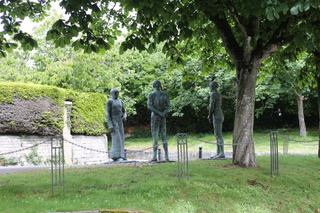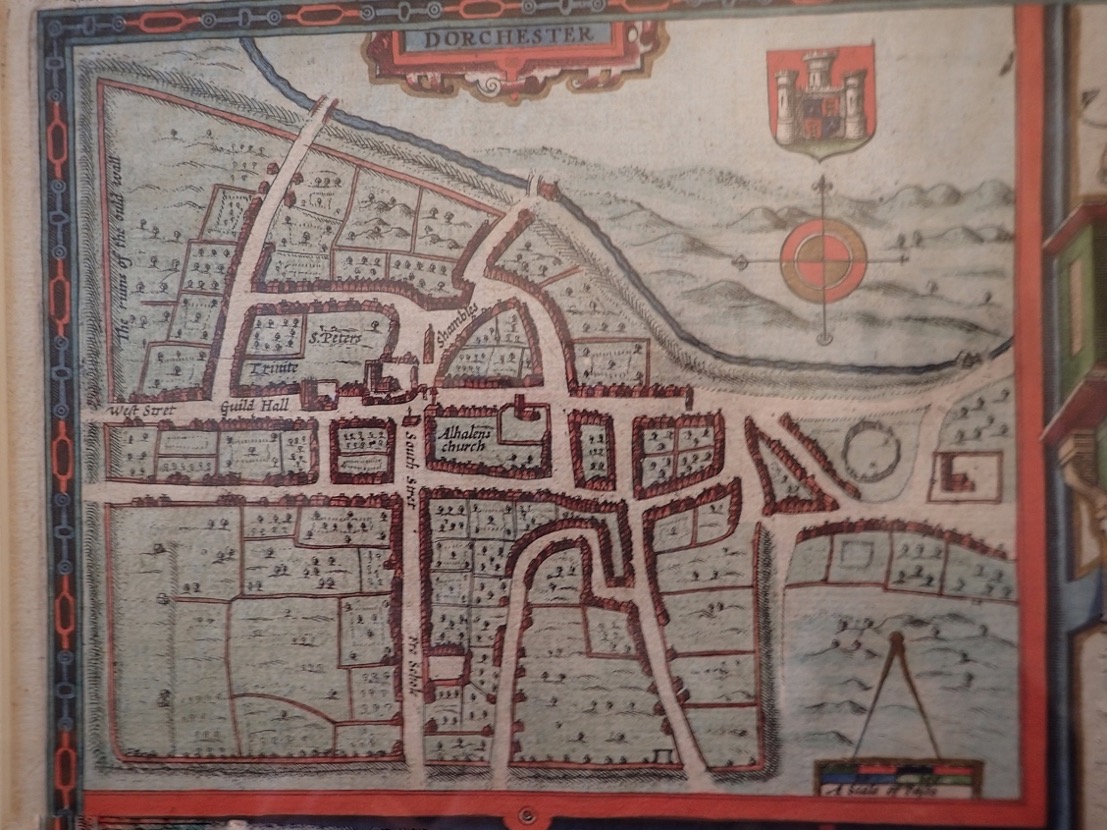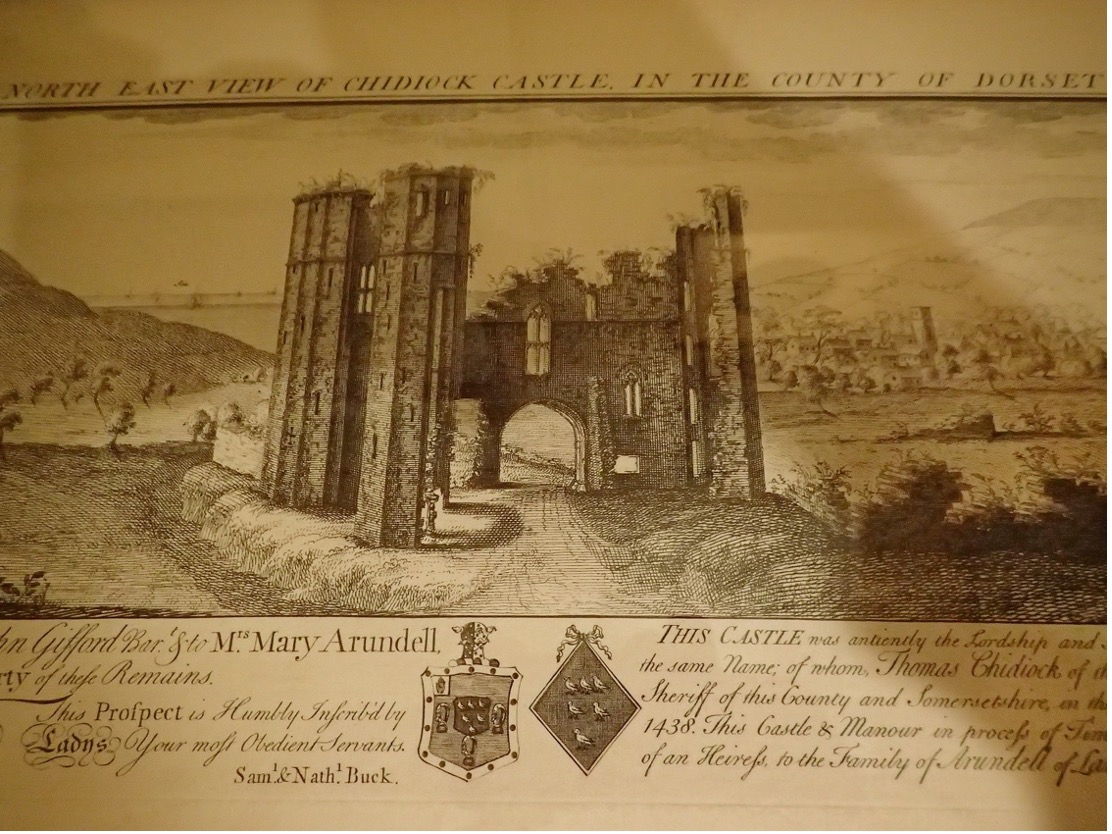Please be aware that this blog piece contains graphic details of Hugh Green’s execution!
In my post this summer on public statues in Dorchester I included Elizabeth Frink’s Memorial to Dorchester’s Catholic Martyrs at the top of Icen Way at the spot known as Gallows Hill (see photo 1).
The last person it commemorates is Father Hugh Green who was put to death in 1642, some forty- eight years after the last such execution on that spot. Gallows Hill is marked on the inset map of the town contained in John Speed’s map of Dorset (see photo 2).
Close to All Souls Day it is appropriate to reflect on Hugh Green’s life and death.
CONTEXT
The Reformation had commenced in England in 1534 when Parliament declared that King Henry VIII would replace the Pope as the head of the Christian Church in England following the latter’s refusal to annul the King’s marriage to Catherine of Aragon. The independence of the new Church of England was reinforced during the remaining years of the King’s reign by the many changes implemented in its governance and by the abolition of the monastic orders. The reforms quickened during the nine-year reign of his only son Edward VI, only to be completely reversed when he was succeeded by his Catholic sister Mary I in 1553.
In 1588 when Queen Mary also died prematurely her protestant sibling Elizabeth was crowned as Queen and the English church once again broke away from Rome and protestant prelates replaced Queen Mary’s Catholic appointees and re-adopted the previous Protestant reforms.
However, a substantial part of the population (estimated to have been 300,000 out of a total of about 4 million) remained loyal to the old faith, and they were ministered to by recusant priests who were obliged to study and qualify for ordination in Catholic Europe.
The six first English Catholics who are remembered by The Martyrs Monument were put to death in the reign of Elizabeth I. There were no further executions during the reign of her successor, James I.
By the time of the accession of his son Charles I in 1625 more extreme forms of Protestantism were gaining strength both in England and in Scotland and increasing their representation amongst the clergy and the House of Commons. The King was High Church and opposed this movement and in 1633 appointed William Laud to the post of Archbishop of Canterbury to reinforce the authority of the bishops, and to maintain the Elizabethan forms of worship and ceremonial close to that of the ‘old faith’.
In 1625, shortly after his accession, King Charles married Princess Henrietta Maria, the daughter of the French King Henri IV and sister of the future Louis XIII, who was a fervent Catholic. On her arrival in London, she was accompanied by her Catholic chaplain and a number of friars. With the King’s consent she practised her faith openly and reopened a Catholic Royal Chapel in Somerset House where she worshipped, accompanied by a growing number of courtiers. This was replaced by a more lavish new chapel designed by her architect Inigo Jones, competed in 1635.
These developments were considered a serious provocation by England’s Puritans who feared that the King would remove the restrictions imposed by the state on Roman Catholics. Coupled with Parliament’s refusal to vote in favour of increased budgets required by the King’s planned expansion of the navy and the military repression of the revolt in Scotland provoked by the Presbyterian Covenanters, this religious conflict was one of the principle causes of the English Civil War.
HUGH GREEN
Hugh Green was born in 1584 to well-to-do Protestant parents who sent him to study at Peterhouse College, Cambridge from which he graduated in 1605. Sometime thereafter he converted to Catholicism and, in 1610, enrolled at the English Catholic College in Douai in northern France. After completing his theological studies, he was ordained in 1610 and joined the Capuchin Order of Friars.
In the late 1630s he returned to England in all probability because of the increasing tolerance of Catholics fostered by the Queen.
By 1641 Hugh Green had become chaplain to Lady Anne Arundell at her castle in Chideock in Dorset. Photo 2 of a print dated 1733 shows the remains of the gatehouse, all that remained after the destruction of the castle during the Civil War.
By the beginning of 1642 the stand-off between the King and Parliament had reached crisis point and the King was obliged to make concessions to the reformists in order to avoid armed conflict. Included amongst these measures was a Royal Proclamation issued on 8th March 1642 ordering all Roman Catholic clergy to leave the country within a period of one month.
News of this measure reached Chideock at the end of the grace period and Hugh Green was arrested in Lyme Regis two days after expiration of the deadline whilst he was seeking a vessel to take him to France. He was immediately taken by armed escort to Dorchester where he was committed to the County Gaol, then at the bottom of High East Street. He was tried and convicted of treason and, having refused to recant, he was condemned to execution by hanging and quartering. By that summer the King had lost control of large parts of the country and the King’s ministers were incapable of intervening, even if they had wanted to.
HIS EXECUTION
His execution was due to take place in mid-August and, at his request, it was scheduled for a Friday, on 19th August 1642.
The most complete and harrowing account of his execution on Gallows Hill is given by the historian Diane Purkiss in ‘The English Civil War – A People’s History’ published in 2006. Her account relies heavily on a letter by Elizabeth Willougby who assisted Rev Green in his ordeal, and which was written shortly afterwards and published in Brussels in 1645.
I quote:
“A crowd was waiting for him. It was eager and hopeful; after the terror of the Irish [the native Catholic Irish had rebelled the previous year against the Protestant English and Scottish settlers who had expropriated their lands], after all Pym [a leading Parliamentarian] had said, it seemed obvious to the spectators that traitors like this one were behind it all. Three women were being hanged too, for various crimes and two had sent him word the night before that they would die in his faith. He absolved them with a sign, because he wasn’t allowed close to them. ‘God be with you sir!’ they cried.
Green gave away his things – his beads, his crucifix, his Agnus Dei, his handkerchief, his book of litanies. However, he would not apologise for what everyone knew to be his treachery. He made a long speech denouncing heresy. Sir Thomas Trencher’s chaplain, who had once been a weaver, was angry, shouting, ‘He Blasphemes. Stop his mouth!’. So the sheriff told Green to stop. Then he prayed instead for unity, for peace, and for the King, and he forgave everyone. He called a Catholic woman, Elizabeth Willougby, to him and she came, and he asked her to say goodbye to his fellow-prisoners, and he blessed her and five others.
He prayed for half an hour. No one could be persuaded to turn the ladder and make him fall. Finally, the hangman, sitting astride the gallows, persuaded a country clown to turn the ladder and Green dropped. He made the sign of the cross three times. And they cut him down with a knife at the end of a long stick, handed up to the hangman by a constable, ‘although’ said Elizabeth ‘I and others did our uttermost to have hindered him’. Their courage was wasted. ‘The man that was to quarter him was a timorous, unskilful man, by trade a barber and his name was Barefoot. He was so long dismembering him that he came to his perfect senses and sat upright.’
Elizabeth Willougby managed to write down in her horror:
‘Then did this butcher cut his belly on both sides, and turn the flap upon his breast, which the holy man feeling he put his left hand upon his bowels, and looking to his bloody hand laid it down by his side, and lifting up his right hand he crossed himself, saying three times, Jesu, Jesu, Jesu, Mercy! The which , although unworthy, I am a witness of, for my hand was on his forehead….all the Catholics were pressed away from him by the unruly multitude except for myself…..Whilst he was thus calling upon Jesus, the butcher did pull a piece of his liver put instead of his heart , and tumbling his guts out every way to see if his heart were not amongst them ; then with his knife he raked in the body……Methought my heart was pulled out of my body to see him in such cruel pains, lifting up his eyes to heaven, and not yet dead. Then I could no longer hold, but cried, ‘Out upon them that did so torment him’. His forehead was bathed in sweat, and blood and water flowed from his eyes and nose. And when on account of the gushing flows of blood his tongue could no longer pronounce the saving name of Jesus, his lips moved and the frequent groans which he uttered from his inmost heart were proof of the most bitter pain and torture which he suffered.’
Hugh Green lingered in the hands of the local barber for half an hour or more. When another Catholic woman pleaded with the sheriff, he was finally put out of his agony. After he had died at last, his heart was cut out, and held up on a spear point, then flung into the fire where a minute before, his genitals had been burned. Some Catholic bystanders, including Elizabeth, tried to take the torn body away for burial, but the crowd stopped them, angrily, and it was all Elizabeth could do to get home without being torn into pieces herself.
Then Green’s head was cut off too and the crowd kicked it about like a football. As a football, in fact; they went on playing till four o’clock – which proved that the man had no power – but since they believed that Catholics were in league with the powers of darkness, they put sticks in the eyes, nose and mouth, and buried the head near the scaffold. They had thought of putting it up on one of Dorchester’s gates as a trophy and a warning, but they had been put off, Elizabeth said, because a previous priest had been so displayed and God had punished the town with the onset of plague.”
Three days later the King, at the head of a small army, raised the Royal Standard in Nottingham and the Civil War commenced, eventually leading to his own execution in Whitehall on 30th January 1649.
When you next pass the Martyrs Memorial, please have a thought for Father Hugh Green, who put to death in such a brutal manner.
Ian Gosling,
Chair of Dorchester Civic Society




Recent Comments